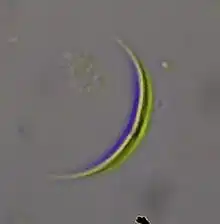| Monoraphidium | |
|---|---|
 | |
| Monoraphidium arcuatum | |
| Scientific classification | |
| (unranked): | Viridiplantae |
| Division: | Chlorophyta |
| Class: | Chlorophyceae |
| Order: | Sphaeropleales |
| Family: | Selenastraceae |
| Genus: | Monoraphidium Komárková-Legnerová |
| Species | |
| |
Monoraphidium is a genus of green algae in the family Selenastraceae.[1] Monoraphidium is found free-floating or attached to surfaces in water, or in soils.[2] It is one of the most common types of phytoplankton in freshwater habitats, and has a cosmopolitan distribution.[3]
Monoraphidium consists of single cells, which are 2-182 by 1-8 micrometers. The cell is straight to lunate to sigmoid or helically shaped. Cells contain a single nucleus, a single parietal chloroplast and a single pyrenoid lacking a starch sheath (or no pyrenoid at all). Reproduction occurs asexually by autospores.[2]
It is similar to and often confused with the related genus Ankistrodesmus, from which it differs by being typically unicellular.[4]
Some species and strains of Monoraphidium, such as Monoraphidium neglectum, are promising candidates for commercial biofuel production.[5]
References
- ↑ See the NCBI webpage on Monoraphidium. Data extracted from the "NCBI taxonomy resources". National Center for Biotechnology Information. Retrieved 2007-03-19.
- 1 2 "Monoraphidium Komárková-Legnerová, 1969 :: AlgaeBase". www.algaebase.org. Retrieved 2023-03-03.
- ↑ Bicudo, Carlos E. M.; Menezes, Mariângela (2006). Gêneros de Algas de Águas Continentais do Brasil: chave para identificação e descrições (2 ed.). RiMa Editora. p. 508. ISBN 857656064X.
- ↑ Matthews, Robin A. (2016). "Freshwater Algae in Northwest Washington, Volume II, Chlorophyta and Rhodophyta". A Collection of Open Access Books and Monographs. Western Washington University. doi:10.25710/fctx-n773.
- ↑ Yee, Willy (2016). "Microalgae from the Selenastraceae as emerging candidates for biodiesel production: A mini review". World Journal of Microbiology and Biotechnology. 32 (4): 64. doi:10.1007/s11274-016-2023-6. PMID 26931604. S2CID 255143072.